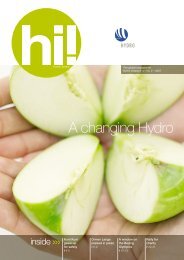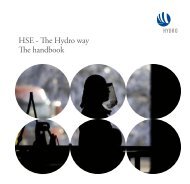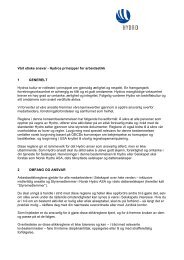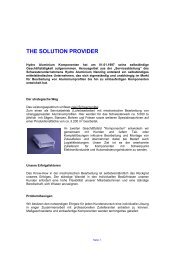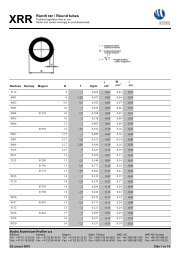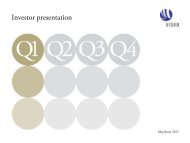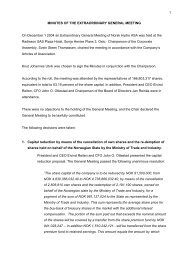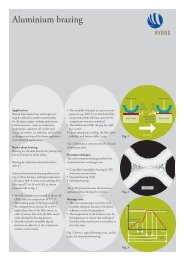Hydro Annual Report 2011b
Hydro Annual Report 2011b
Hydro Annual Report 2011b
Create successful ePaper yourself
Turn your PDF publications into a flip-book with our unique Google optimized e-Paper software.
112<br />
RISK REVIEW<br />
Risk factors<br />
leading to production interruptions in our plants could have a material adverse effect on our financial results and cash flows.<br />
Although <strong>Hydro</strong> maintains insurance to protect against certain risks in such amounts as it considers reasonable, its insurance<br />
may not cover all the potential risks associated with <strong>Hydro</strong>'s operations.<br />
<strong>Hydro</strong> is subject to a broad range of laws and regulations<br />
<strong>Hydro</strong> is subject to a broad range of laws and regulations in the countries and legal jurisdictions in which we operate. These<br />
laws and regulations impose stringent standards and requirements and potential liabilities regarding accidents and injuries, the<br />
construction and operation of our plants and facilities, air and water pollutant emissions, the storage, treatment and discharge<br />
of waste waters, the use and handling of hazardous or toxic materials, waste disposal practices, and the remediation of<br />
environmental contamination, among other things. We believe we are in material compliance with currently applicable laws<br />
and regulations. However, these laws and regulations may change or new laws and regulations enacted requiring substantial<br />
costs for compliance, reducing profitability or having a negative impact on our competitive position.<br />
<strong>Hydro</strong> may be subject to liabilities relating to businesses transferred to successor companies<br />
<strong>Hydro</strong> has certain joint liabilities under Norwegian statutory regulations following from demergers. Under the Norwegian<br />
public limited companies act section 14-11, <strong>Hydro</strong> and Statoil are jointly liable for liabilities accrued before the demerger date<br />
of October 1, 2007. This statutory liability is unlimited in time, but is limited in amount to the net value allocated to the nondefaulting<br />
party in the demerger. Similarly, <strong>Hydro</strong> and Yara International ASA are jointly liable for liabilities accrued before<br />
the demerger date of March 24, 2004, on the same conditions.<br />
Rights and legal remedies may be limited for certain classes of shareholders<br />
The exercise of shareholder rights such as voting and preferential subscription rights may not be available to beneficial<br />
shareholders whose shares are registered in a nominee account, and not in the shareholders' own names with the Norwegian<br />
Central Securities Depository, Verdipapirsentralen (VPS). <strong>Hydro</strong> cannot guarantee that beneficial shareholders will receive the<br />
notice for a general meeting in time to instruct their nominees to affect a re-registration of their shares. <strong>Hydro</strong> is organized<br />
under the laws of the Kingdom of Norway. It may be difficult for investors to effect service of process outside Norway upon<br />
<strong>Hydro</strong> or its directors and executive officers, or to enforce against <strong>Hydro</strong> or its directors and executive officers judgments<br />
obtained in other jurisdictions. Norwegian courts are unlikely to apply other than Norwegian law when deciding on civil<br />
liability claims under securities laws.<br />
Market and commercial risk<br />
Risk management in <strong>Hydro</strong> is based on the principle that risk evaluation is an integral part of all business activities. Business<br />
areas have the main responsibility for relevant risk management within their area. Corporate staff units establish policies and<br />
procedures for managing risk and coordinate an overall enterprise risk assessment.<br />
Financial position<br />
<strong>Hydro</strong>'s main strategy for mitigating risk related to volatility in cash flow is to maintain a strong balance sheet. Specific key<br />
financial ratios are targeted over the business cycle reflecting a solid financial position and strong credit worthiness. Examples<br />
include an adjusted net interest-bearing debt/equity ratio below 0.55 and a ratio of funds from operations to adjusted net<br />
interest-bearing debt above a level of 0.40. In addition, <strong>Hydro</strong> has established guidelines for liquidity reserves and for the<br />
profile of installment payments on debt in order to secure its financial position.<br />
Liquidity risk<br />
<strong>Hydro</strong>'s liquidity position at the end of 2011 is considered satisfactory and we do not expect any new long-term funding<br />
requirements in 2012. An undrawn committed credit facility from banks amounting to USD 1,7 billion remained outstanding<br />
from the previous year. A stand-by bank facility of NOK 10 billion was terminated at the beginning of 2011 as our liquidity<br />
position was considered adequate. <strong>Hydro</strong> continues to focus on cash flow and credit risk throughout the organization. We take a<br />
proactive approach toward customers to reduce credit risk and also monitor the financial performance of key suppliers in order<br />
to reduce the risk of default on operations and key projects.<br />
Prices and currency<br />
<strong>Hydro</strong>'s operating results are primarily affected by price developments of its main products, aluminium and power, in addition<br />
to fluctuations in the value of the Norwegian krone to the U.S. dollar and the Euro, which are the most significant currencies<br />
for <strong>Hydro</strong>. The Vale aluminium acquisition has increased our exposure to aluminium price developments and the Brazilian



